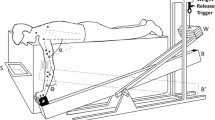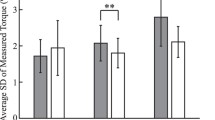Abstract
We tested the null hypotheses that neither age, gender nor muscle pre-cocontraction state affect the latencies of changes in upper extremity kinematics or elbow muscle activity following an impulsive force to the hand. Thirty-eight healthy young and older adult volunteers lay prone on an apparatus with shoulders flexed 75° and arms slightly flexed. The non-dominant hand was subjected to three trials of impulsive loading with arm muscles precontracted to 25, 50, or 75% of maximum pre-cocontraction levels. Limb kinematic data and upper extremity electromyographic (EMG) activity were acquired. The results showed that pre-cocontraction muscle level (p < 0.001) and gender (p < 0.05 for wrist and shoulder) affected joint displacement onset times and age affected EMG onset times (p < 0.05). The peak applied force (F 1) occurred a mean (± SD) 27 (± 2) ms after impact. The latencies for the wrist, elbow, and shoulder displacements were 21 ± 3, 29 ± 5, and 34 ± 7 ms, respectively. Because the latencies for elbow flexion and lateral triceps EMG were 23 ± 5 and 84 ± 8 ms, respectively, muscle pre-activation rather than stretch reflexes prevent arm buckling under impulsive end loads.




Similar content being viewed by others
References
Augat, P., H. Iida, Y. Jiang, E. Diao, and H. K. Genant. Distal radius fractures: mechanisms of injury and strength prediction by bone mineral assessment. J. Orthop. Res. 16:629–635, 1998.
Blanpied, P., and G. L. Smidt. The difference in stiffness of the active plantarflexors between young and elderly human females. J. Gerontol. 48:M58–M63, 1993.
Brown, M., I. Engberg, and P. Matthews. The relative sensitivity to vibration of muscle receptors of the cat. J. Physiol. 192:773–800, 1967.
Brown, I. E., and G. E. Loeb. A reductionist approach to creating and using neuromusculoskeletal models. In: Biomechanics and Neural Control of Movement and Posture, edited by J. M. Winters, and P. E. Crago. New York: Springer, 2000, pp. 148–163.
Burke, D., K. Hagbarth, L. Löfstedt, and B. G. Wallin. The responses of human muscle spindle endings to vibration of non-contracting muscles. J. Physiol. 261:673–693, 1976.
Cheng, S., J. Timonen, and H. Suominen. Elastic wave propagation in bone in vivo: methodology. J. Biomech. 28:471–478, 1995.
Cuccurullo, S. Electrodiagnostic medicine and clinical neuromuscular physiology. In: Physical Medicine and Rehabilitation Board Review, edited by S. Cuccurullo. New York: Demos Medical Publishing, 2004, pp. 315–319.
Cummings, S., and M. Nevitt. Non-skeletal determinants of fractures: the potential importance of the mechanics of falls. Osteoporos. Int. 4:S67–S70, 1994.
DeGoede, K., and J. Ashton-Miller. Fall arrest strategy affects peak hand impact force in a forward fall. J. Biomech. 35:843–848, 2002.
DeGoede, K., J. Ashton-Miller, and A. Schultz. Fall-related upper body injuries in the older adult: a review of the biomechanical issues. J. Biomech. 36:1043–1053, 2003.
DeGoede, K. M., J. A. Ashton-Miller, A. B. Schultz, and N. B. Alexander. Biomechanical factors affecting the peak hand reaction force during the bimanual arrest of a moving mass. J. Biomech. Eng. 124:107, 2002.
Dietz, V., J. Noth, and D. Schmidtbleicher. Interaction between pre-activity and stretch reflex in human triceps brachii during landing from forward falls. J. Physiol. 311:113–125, 1981.
Flynn, T., P. Cavanagh, H. Sommer, and J. Derr. Tibial flexural wave propagation in vivo: potential for bone stress injury risk assessment. Work 18:151–160, 2002.
Frampton, R., A. Morris, P. Thomas, and G. Bodiwala. An overview of upper extremity injuries to car occupants in UK vehicle crashes. In: Proceedings of the International Research Council on the Biomechanics of Impact. Germany: Hannover, 1997.
Frykman, G. Fracture of the Distal Radius Including Sequelae—Shoulder–Hand–Finger Syndrome, Disturbance in the Distal Radio-Ulnar Joint and Impairment of Nerve Function: A Clinical and Experimental Study. Acta Orthopaedica Scandinavica Supplementum, Vol. 108. Copenhagen: Munksgaard, 1967.
Hsiao, E., and S. Robinovitch. Common protective movements govern unexpected falls from standing height. J. Biomech. 31:1–9, 1998.
Kurtzer, I., J. A. Pruszynski, and S. H. Scott. Long-latency and voluntary responses to an arm displacement can be rapidly attenuated by perturbation offset. J. Neurophysiol. 103:3195–3204, 2010.
Lee, Y., and J. A. Ashton-Miller. The effects of gender, level of co-contraction, and initial angle on elbow extensor muscle stiffness and damping under a step increase in elbow flexion moment. Ann. Biomed. Eng. 39:2542–2549, 2011.
Lo, J., and J. A. Ashton-Miller. Effect of upper and lower extremity control strategies on predicted injury risk during simulated forward falls: a study in healthy young adults. J. Biomech. Eng. 130:041015, 2008.
Lo, J., G. McCabe, K. DeGoede, H. Okuizumi, and J. Ashton-Miller. On reducing hand impact force in forward falls: results of a brief intervention in young males. Clin. Biomech. 18:730–736, 2003.
McDowell, M. A., C. D. Fryar, C. L. Ogden, and K. M. Flegal. Anthropometric reference data for children and adults: United States, 2003–2006: US Department of Health and Human Services. National Center for Health Statistics: Centers for Disease Control and Prevention, 2008.
Norris, A. H., N. W. Shock, and I. H. Wagman. Age changes in the maximum conduction velocity of motor fibers of human ulnar nerves. J. Appl. Physiol. 5:589–593, 1953.
Pierrot-Deseilligny, E., and D. Burke. The Circuitry of the Human Spinal Cord: Its Role in Motor Control and Movement Disorders. Cambridge: Cambridge University Press, pp. 63–112, 2005.
Pruszynski, J. A., and S. H. Scott. Optimal feedback control and the long-latency stretch response. Exp. Brain Res. 218:341–359, 2012.
Saha, S., and R. S. Lakes. The effect of soft tissue on wave-propagation and vibration tests for determining the in vivo properties of bone. J. Biomech. 10:393–401, 1977.
Taylor, P. K. Non-linear effects of age on nerve conduction in adults. J. Neurol. Sci. 66:223–234, 1984.
Thelen, D. G., J. A. Ashton-Miller, A. B. Schultz, and N. B. Alexander. Do neural factors underlie age differences in rapid ankle torque development? J. Am. Geriatr. Soc. 44:804–808, 1996.
Thelen, D. G., A. B. Schultz, N. B. Alexander, and J. A. Ashton-Miller. Effects of age on rapid ankle torque development. J. Gerontol. A-Biol. 51:M226–M232, 1996.
Troy, K. L., and M. D. Grabiner. Asymmetrical ground impact of the hands after a trip-induced fall: experimental kinematics and kinetics. Clin. Biomech. 22:1088–1095, 2007.
Tsuchikane, A., Y. Nakatsuchi, and A. Nomura. The influence of joints and soft tissue on the natural frequency of the human tibia using the impulse response method. Proc. Inst. Mech. Eng. H 209:149–155, 1995.
Winter, D. A. Biomechanics and Motor Control of Human Movement. New York: Wiley, pp. 59–85, 2005.
Wong, F. Y., S. Pal, and S. Saha. The assessment of in vivo bone condition in humans by impact response measurement. J. Biomech. 16:849–856, 1983.
Acknowledgments
The authors wish to thank Kurt M. DeGoede, Ph.D., for conducting pilot studies11 leading to this paper. We thank the subjects for their participation and the financial support of PHS Grant P30 AG 024824 is gratefully acknowledged.
Author information
Authors and Affiliations
Corresponding author
Additional information
Associate Editor Thurmon E. Lockhart oversaw the review of this article.
Rights and permissions
About this article
Cite this article
Lee, Y., Ashton-Miller, J.A. Age and Gender Effects on the Proximal Propagation of an Impulsive Force Along the Adult Human Upper Extremity. Ann Biomed Eng 42, 25–35 (2014). https://doi.org/10.1007/s10439-013-0900-9
Received:
Accepted:
Published:
Issue Date:
DOI: https://doi.org/10.1007/s10439-013-0900-9




